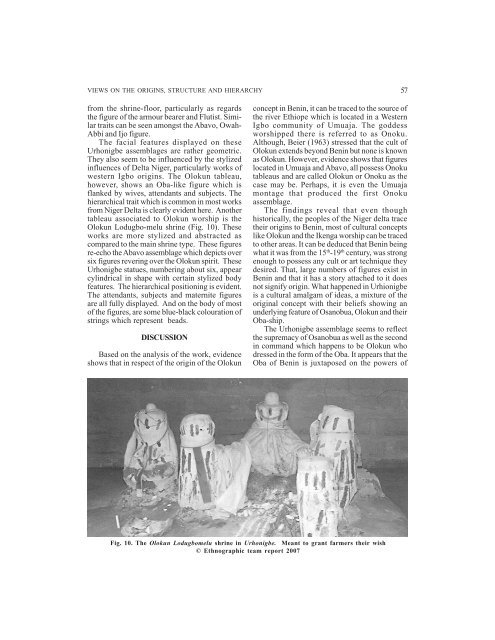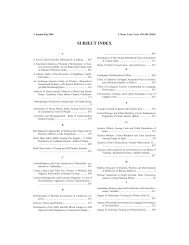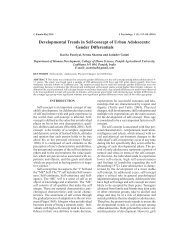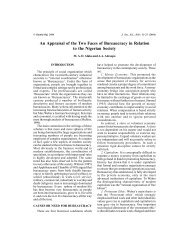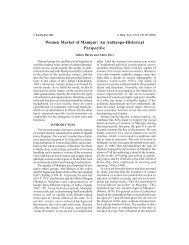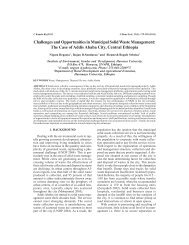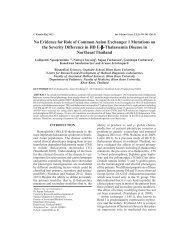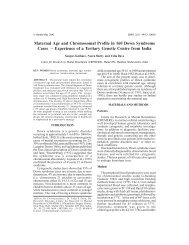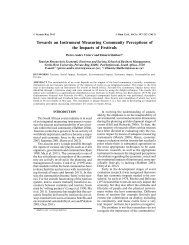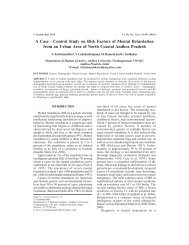Views on the Origins, Structure and Hierarchy of Some Niger Delta ...
Views on the Origins, Structure and Hierarchy of Some Niger Delta ...
Views on the Origins, Structure and Hierarchy of Some Niger Delta ...
You also want an ePaper? Increase the reach of your titles
YUMPU automatically turns print PDFs into web optimized ePapers that Google loves.
VIEWS ON THE ORIGINS, STRUCTURE AND HIERARCHY<br />
from <strong>the</strong> shrine-floor, particularly as regards<br />
<strong>the</strong> figure <strong>of</strong> <strong>the</strong> armour bearer <strong>and</strong> Flutist. Similar<br />
traits can be seen am<strong>on</strong>gst <strong>the</strong> Abavo, Owah-<br />
Abbi <strong>and</strong> Ijo figure.<br />
The facial features displayed <strong>on</strong> <strong>the</strong>se<br />
Urh<strong>on</strong>igbe assemblages are ra<strong>the</strong>r geometric.<br />
They also seem to be influenced by <strong>the</strong> stylized<br />
influences <strong>of</strong> <strong>Delta</strong> <strong>Niger</strong>, particularly works <strong>of</strong><br />
western Igbo origins. The Olokun tableau,<br />
however, shows an Oba-like figure which is<br />
flanked by wives, attendants <strong>and</strong> subjects. The<br />
hierarchical trait which is comm<strong>on</strong> in most works<br />
from <strong>Niger</strong> <strong>Delta</strong> is clearly evident here. Ano<strong>the</strong>r<br />
tableau associated to Olokun worship is <strong>the</strong><br />
Olokun Lodugbo-melu shrine (Fig. 10). These<br />
works are more stylized <strong>and</strong> abstracted as<br />
compared to <strong>the</strong> main shrine type. These figures<br />
re-echo <strong>the</strong> Abavo assemblage which depicts over<br />
six figures revering over <strong>the</strong> Olokun spirit. These<br />
Urh<strong>on</strong>igbe statues, numbering about six, appear<br />
cylindrical in shape with certain stylized body<br />
features. The hierarchical positi<strong>on</strong>ing is evident.<br />
The attendants, subjects <strong>and</strong> maternite figures<br />
are all fully displayed. And <strong>on</strong> <strong>the</strong> body <strong>of</strong> most<br />
<strong>of</strong> <strong>the</strong> figures, are some blue-black colourati<strong>on</strong> <strong>of</strong><br />
strings which represent beads.<br />
DISCUSSION<br />
Based <strong>on</strong> <strong>the</strong> analysis <strong>of</strong> <strong>the</strong> work, evidence<br />
shows that in respect <strong>of</strong> <strong>the</strong> origin <strong>of</strong> <strong>the</strong> Olokun<br />
c<strong>on</strong>cept in Benin, it can be traced to <strong>the</strong> source <strong>of</strong><br />
<strong>the</strong> river Ethiope which is located in a Western<br />
Igbo community <strong>of</strong> Umuaja. The goddess<br />
worshipped <strong>the</strong>re is referred to as Onoku.<br />
Although, Beier (1963) stressed that <strong>the</strong> cult <strong>of</strong><br />
Olokun extends bey<strong>on</strong>d Benin but n<strong>on</strong>e is known<br />
as Olokun. However, evidence shows that figures<br />
located in Umuaja <strong>and</strong> Abavo, all possess Onoku<br />
tableaus <strong>and</strong> are called Olokun or Onoku as <strong>the</strong><br />
case may be. Perhaps, it is even <strong>the</strong> Umuaja<br />
m<strong>on</strong>tage that produced <strong>the</strong> first Onoku<br />
assemblage.<br />
The findings reveal that even though<br />
historically, <strong>the</strong> peoples <strong>of</strong> <strong>the</strong> <strong>Niger</strong> delta trace<br />
<strong>the</strong>ir origins to Benin, most <strong>of</strong> cultural c<strong>on</strong>cepts<br />
like Olokun <strong>and</strong> <strong>the</strong> Ikenga worship can be traced<br />
to o<strong>the</strong>r areas. It can be deduced that Benin being<br />
what it was from <strong>the</strong> 15 th -19 th century, was str<strong>on</strong>g<br />
enough to possess any cult or art technique <strong>the</strong>y<br />
desired. That, large numbers <strong>of</strong> figures exist in<br />
Benin <strong>and</strong> that it has a story attached to it does<br />
not signify origin. What happened in Urhi<strong>on</strong>igbe<br />
is a cultural amalgam <strong>of</strong> ideas, a mixture <strong>of</strong> <strong>the</strong><br />
original c<strong>on</strong>cept with <strong>the</strong>ir beliefs showing an<br />
underlying feature <strong>of</strong> Osanobua, Olokun <strong>and</strong> <strong>the</strong>ir<br />
Oba-ship.<br />
The Urh<strong>on</strong>igbe assemblage seems to reflect<br />
<strong>the</strong> supremacy <strong>of</strong> Osanobua as well as <strong>the</strong> sec<strong>on</strong>d<br />
in comm<strong>and</strong> which happens to be Olokun who<br />
dressed in <strong>the</strong> form <strong>of</strong> <strong>the</strong> Oba. It appears that <strong>the</strong><br />
Oba <strong>of</strong> Benin is juxtaposed <strong>on</strong> <strong>the</strong> powers <strong>of</strong><br />
Fig. 10. The Olokun Lodugbomelu shrine in Urh<strong>on</strong>igbe. Meant to grant farmers <strong>the</strong>ir wish<br />
© Ethnographic team report 2007<br />
57


